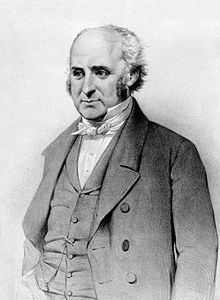Fields medicine Siblings James Henthorn Todd Known for Todd's paresis | Role Physician Name Robert Todd | |
 | ||
Books The descriptive and physiological anatomy of the brain, spinal cord and ganglions Education Trinity College, Dublin, Pembroke College, Oxford | ||
Robert Bentley Todd (9 April 1809 – 30 January 1860) was an Irish-born physician who is best known for describing the condition postictal paralysis in his Lumleian Lectures in 1849 now known as Todd's palsy. He was the younger brother of noted writer and minister James Henthorn Todd.
Contents
Early life
The son of physician Charles Hawkes Todd (1784 - 1826) and Eliza Bentley (1783 - ), Robert was born in Dublin, Ireland, 9 April 1809. He attended day school and was tutored by the Rev. William Higgin (1793 - 1867), who was afterwards the bishop of Derry & Raphoe. Todd entered Trinity College in 1825, intending to study for the bar. When his father died the next year, he switched to medicine and became a resident pupil at a hospital in Dublin. He was a student of Robert Graves, and graduated B.A. at Trinity in 1829. He became licensed at the Royal College of Surgeons in Ireland two years later.
Professional life
He then moved to London, where he practised medicine and lectured. He received a M.S. at Pembroke College, Oxford in 1832, a B.M. the following year, and a D.M. in 1836. He travelled widely in Europe, lecturing and becoming acquainted with a number of eminent men in his field. He took the license of the Royal College of Physicians in 1833, became a Fellow in 1837, and a Censor in 1839–40. He was made a Fellow of the Royal Society and served on the council in 1838-9. In 1836-7 he served on a sub-committee of the British Association to inquire into the motions of the heart, and in 1839–40 was Examiner for the University of London. In 1844 he was elected Fellow of the Royal College of Surgeons.
Todd's abiding interests were in physiological medicine (a field then in its infancy) and in the improvement of hospital nursing, and always held to a high standard of general and religious knowledge. He became a Professor at King's College London in 1836 and was prominent in the opening of King's College Hospital in 1840, and in the founding of its new building in 1851. It was largely through his advocacy that the Sisters of St. John's commenced nursing at King's College Hospital.
Todd's increasing practice forced him to resign his professorship in 1853, and in the final years of his life his practice grew enormously. In failing health, he was finally forced to give up his clinical lectures at the hospital that he had helped found.
Robert Bentley Todd died in his consulting rooms at his home located at 26 Brook Street, Grosvenor Square, Westminster, on 30 January 1860. He was buried at All Souls, Kensal Green, 4 February 1860. At Hassel by Hull, Yorkshire, Robert married Elizabeth Mary née Hart (1814 – ) 20 December 1836. The younger sister of Capt. John Hart M.P. (1808 - 1873) [Australian Dictionary of Biography], Elizabeth was baptised at St. John's, Hackney, the daughter of journalist John Harriot Hart & Mary née Glanville on 23 June 1814. In one of the most sensational cases of its day, John Herriot Hart co-owner The Whig Independent newspaper was imprisoned in Gloucester Goal for liable [Annual Register vol 72 p. 74], before being transported to Tenerife. It is presumed that he died on the return voyage to England. The children of Robert Bentley Todd & Elizabeth née Hart; Elizabeth Marion Todd (1841 - 1917) baptised at St. Margaret's, Westminster, 23 June 1841, died at 2 Connaught Square, 8 July 1917 [Times 8 July 1917, p. 1], Alice Margaret (b. 1843), Bertha Jane Johnson (1846 - 1927) born 20 February 1846, baptised St. Martin in the Fields, 5 March 1846, wife of Rev. Arthur Henry Johnson C.B.E. (1845 - 1927) lecturer at Oxford [Alumni Oxonienses 1715 - 1886] and James Henthorn Todd (1848–1891) baptised at St. Martin in the Fields 23 November 1847, who died near Bombay, India, 14 August 1891 [Times 20 August 1891, p. 1]. A statue of Todd was erected in the great hall of King's College Hospital.
Legacy
Todd was a popular lecturer, and was noted for his accuracy in the observation of disease, correctness of diagnosis, and clarity and exactness in expressing his views. He was the first to lay down definite principles for the treatment of serious cases of fever. In his Lumleian lectures he discussed the nature and treatment of various forms of delirium, and showed the significant role that exhaustion played in patient deterioration, and how bleeding and lowering remedies contributed to deterioration, while supporting treatment was followed by relief.
Todd was a prolific contributor to medical publications, including The Cyclopaedia of Anatomy and Physiology. He immediately integrated newly available technology, particularly the microscope, into the study and practice of medicine, and was a driving force in raising the standards of medical knowledge.
Todd is remembered for his prescription of a hot drink of brandy, canella (white cinnamon), sugar syrup and water. This is called a "Hot toddy".
